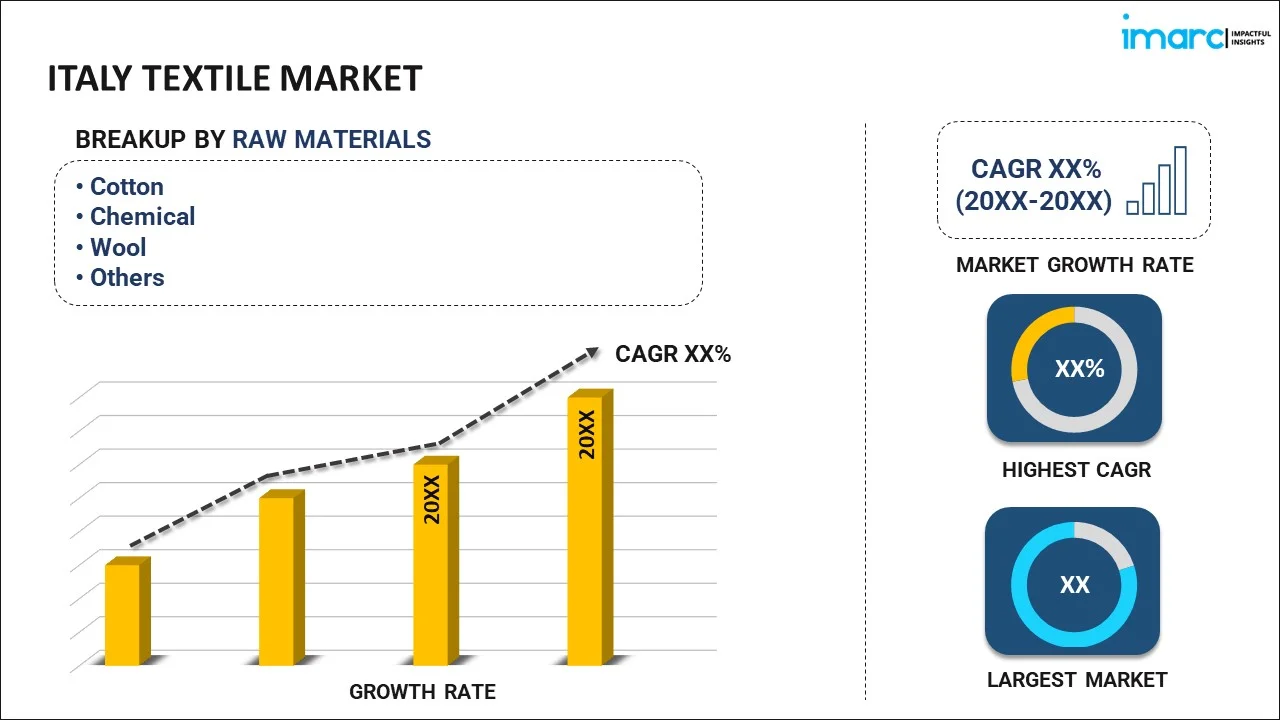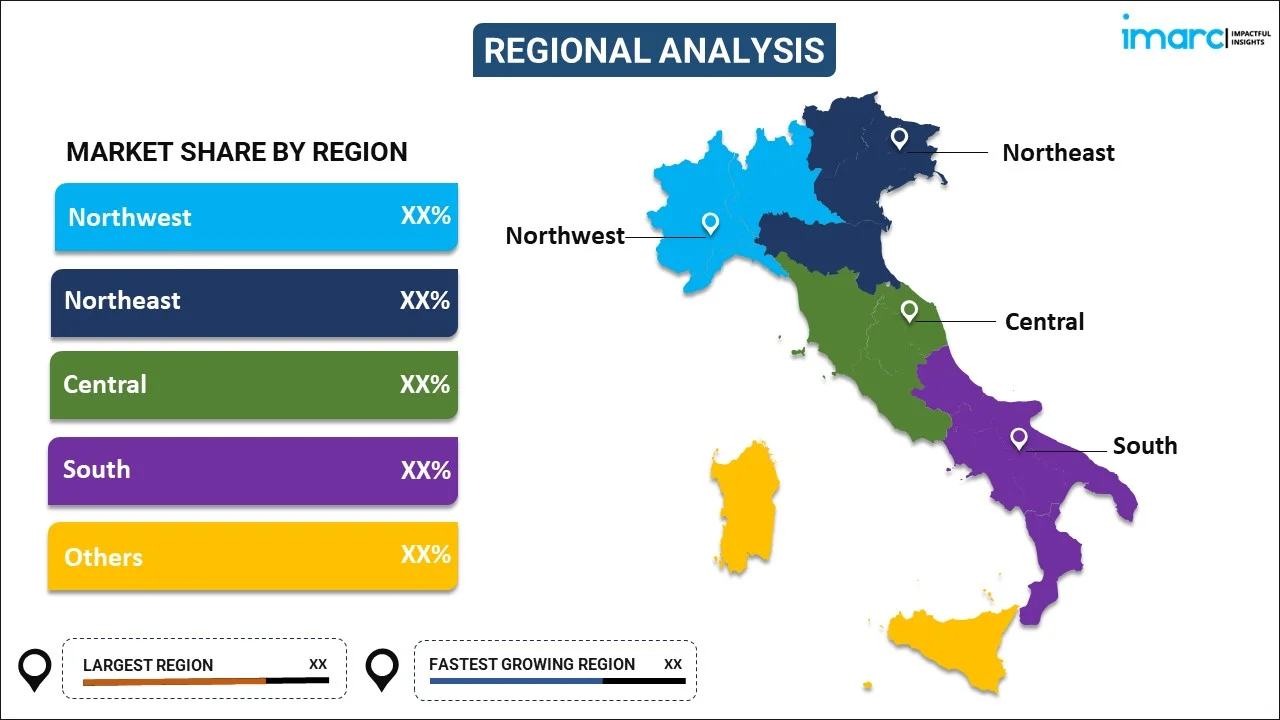
Italy Textile Market Report by Raw Material (Cotton, Chemical, Wool, Silk, and Others), Product (Natural Fibers, Polyesters, Nylon, and Others), Application (Household, Technical, Fashion and Clothing, and Others), and Region 2025-2033
Italy Textile Market Overview:
The Italy textile market size reached USD 26.9 Billion in 2024. Looking forward, IMARC Group expects the market to reach USD 34.1 Billion by 2033, exhibiting a growth rate (CAGR) of 2.70% during 2025-2033. The market is driven by the growing additive manufacturing (AM), innovations in technology, thriving fashion industry, quality and craftmanship, expansion of e-commerce platforms, and rising numbers of social media users.
|
Report Attribute
|
Key Statistics
|
|---|---|
|
Base Year
|
2024 |
|
Forecast Years
|
2025-2033 |
|
Historical Years
|
2019-2024
|
| Market Size in 2024 | USD 26.9 Billion |
| Market Forecast in 2033 | USD 34.1 Billion |
| Market Growth Rate (2025-2033) | 2.70% |
Italy Textile Market Trends:
Growing Additive Manufacturing (AM)
An article published in 2024 on the website of the International Trade Administration (ITA) shows that the Italy AM market is estimated at $600 million. Italian textile companies can leverage AM to create unique, personalized designs and products for their customers, leading to increased customer satisfaction and loyalty. AM allows for quick and cost-effective prototyping of textile products. Italian designers and manufacturers can rapidly iterate designs, reducing time to market and speeding up the product development cycle. In addition, traditional textile manufacturing methods often have limitations when it comes to producing complex geometries. With AM, intricate designs and structures can be easily achieved, enabling Italian textile companies to create innovative and avant-garde products that stand out in the market.
Besides this, AM is expected to contribute positively to the textile sector by minimizing on wastage of materials in production. This aligns with Italy's focus on sustainability and eco-friendly practices, making AM an attractive option for textile manufacturers looking to reduce their environmental footprint. Moreover, AM creates opportunities to test innovative materials and combinations of them in the textile industry. Italian companies can use numerous kinds of materials, including biodegradable and recyclable ones, to produce environmentally friendly textiles.
Rising Number of Social Media Users
As per an article published in 2024 on the website of the International Trade Administration (ITA), in Italy 44 million people, which means 75% of the population, use social media, with YouTube, Facebook, and Instagram. Social media platforms provide Italian textile companies with an opportunity to showcase their products to a wider audience. Textile brands can better target potential customers through social media websites such as Instagram, Facebook, and Pinterest. This visibility increases the penetration of the Italian textile market among new clients. Furthermore, social media also allows firms in the textile industry to interact with people directly. Italian brands can engage with their audience, respond to inquiries, and receive feedback in real-time, fostering stronger relationships with customers. This direct communication allows companies to better understand consumer preferences and tailor their products to meet market demands, thereby supporting the growth in the textile industry. Social media platforms serve as a source of inspiration and trend identification for people. Italian textile companies monitor social media trends to identify emerging styles, colors, and design preferences among their target audience.
Italy Textile Market News:
- April 4, 2024: Kering announced the acquisition of the company owning the iconic and historic Milanese building on via Monte Napoleone 8, for a consideration of approximately €1.3 billion, from a subsidiary of Blackstone Property Partners Europe.
- April 1, 2024: The Italian Trade Agency in collaboration with Association of Italian Textile Machinery Manufacturers (ACIMIT) announced a delegation visit of 11 prominent Italian textile machinery manufacturers to India for showcases in Delhi and Mumbai. The events aim to strengthen Indo-Italian business ties by introducing the latest technologies in textile production, covering the entire value chain.
Italy Textile Market Segmentation:
IMARC Group provides an analysis of the key trends in each segment of the market, along with forecasts at the country level for 2025-2033. Our report has categorized the market based on raw material, product, and application.
Raw Material Insights:

- Cotton
- Chemical
- Wool
- Silk
- Others
The report has provided a detailed breakup and analysis of the market based on the raw material. This includes cotton, chemical, wool, silk, and others.
Product Insights:
- Natural Fibers
- Polyesters
- Nylon
- Others
A detailed breakup and analysis of the market based on the product have also been provided in the report. This includes natural fibers, polyesters, nylon, and others.
Application Insights:
- Household
- Technical
- Fashion and Clothing
- Others
The report has provided a detailed breakup and analysis of the market based on the application. This includes household, technical, fashion and clothing, and others.
Regional Insights:

- Northwest
- Northeast
- Central
- South
- Others
The report has also provided a comprehensive analysis of all the major regional markets, which include Northwest, Northeast, Central, South and Others.
Competitive Landscape:
The market research report has also provided a comprehensive analysis of the competitive landscape. Competitive analysis such as market structure, key player positioning, top winning strategies, competitive dashboard, and company evaluation quadrant has been covered in the report. Also, detailed profiles of all major companies have been provided.
Italy Textile Market Report Coverage:
| Report Features | Details |
|---|---|
| Base Year of the Analysis | 2024 |
| Historical Period | 2019-2024 |
| Forecast Period | 2025-2033 |
| Units | Billion USD |
| Scope of the Report | Exploration of Historical Trends and Market Outlook, Industry Catalysts and Challenges, Segment-Wise Historical and Future Market Assessment:
|
| Raw Materials Covered | Cotton, Chemical, Wool, Silk, Others |
| Products Covered | Natural Fibers, Polyesters, Nylon, Others |
| Applications Covered | Household, Technical, Fashion and Clothing, Others |
| Regions Covered | Northwest, Northeast, Central, South, Others |
| Customization Scope | 10% Free Customization |
| Post-Sale Analyst Support | 10-12 Weeks |
| Delivery Format | PDF and Excel through Email (We can also provide the editable version of the report in PPT/Word format on special request) |
Key Questions Answered in This Report:
- How has the Italy textile market performed so far and how will it perform in the coming years?
- What has been the impact of COVID-19 on the Italy textile market?
- What is the breakup of the Italy textile market on the basis of raw material?
- What is the breakup of the Italy textile market on the basis of product?
- What is the breakup of the Italy textile market on the basis of application?
- What are the various stages in the value chain of the Italy textile market?
- What are the key driving factors and challenges in the Italy textile?
- What is the structure of the Italy textile market and who are the key players?
- What is the degree of competition in the Italy textile market?
Key Benefits for Stakeholders:
- IMARC’s industry report offers a comprehensive quantitative analysis of various market segments, historical and current market trends, market forecasts, and dynamics of the Italy textile market from 2019-2033.
- The research report provides the latest information on the market drivers, challenges, and opportunities in the Italy textile market.
- Porter's five forces analysis assist stakeholders in assessing the impact of new entrants, competitive rivalry, supplier power, buyer power, and the threat of substitution. It helps stakeholders to analyze the level of competition within the Italy textile industry and its attractiveness.
- Competitive landscape allows stakeholders to understand their competitive environment and provides an insight into the current positions of key players in the market.
Need more help?
- Speak to our experienced analysts for insights on the current market scenarios.
- Include additional segments and countries to customize the report as per your requirement.
- Gain an unparalleled competitive advantage in your domain by understanding how to utilize the report and positively impacting your operations and revenue.
- For further assistance, please connect with our analysts.
 Inquire Before Buying
Inquire Before Buying
 Speak to an Analyst
Speak to an Analyst
 Request Brochure
Request Brochure
 Request Customization
Request Customization




.webp)




.webp)












